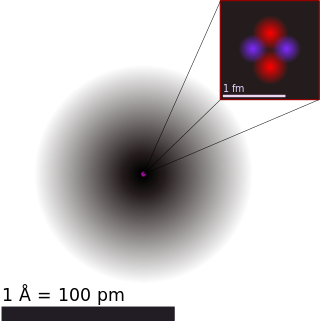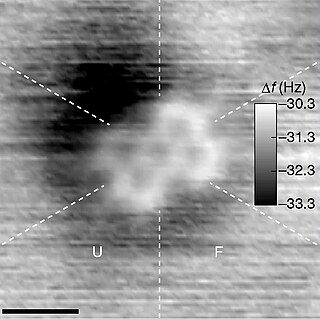
Atomic theory is the scientific theory that matter is composed of particles called atoms. The concept that matter is ultimately composed of discrete particles is an ancient idea, but the concept gained scientific credence from the beginning of the 19th century when scientists found it could explain how the chemical elements reacted with each other. In more specific terms, the atom was defined as the basic particle of a chemical element. By the end of the 19th century, the atomic theory had gained full acceptance in the scientific community. It is one of the most important scientific discoveries in history.

Khmer is an Austroasiatic language spoken by the Khmer people, and the official and national language of Cambodia. Khmer has been influenced considerably by Sanskrit and Pali, especially in the royal and religious registers, through Hinduism and Buddhism. It is also the earliest recorded and earliest written language of the Mon–Khmer family, predating Mon and Vietnamese, due to Old Khmer being the language of the historical empires of Chenla, Angkor and, presumably, their earlier predecessor state, Funan.

A molecule is a group of two or more atoms held together by attractive forces known as chemical bonds; depending on context, the term may or may not include ions which satisfy this criterion. In quantum physics, organic chemistry, and biochemistry, the distinction from ions is dropped and molecule is often used when referring to polyatomic ions.

Smoke is a suspension of airborne particulates and gases emitted when a material undergoes combustion or pyrolysis, together with the quantity of air that is entrained or otherwise mixed into the mass. It is commonly an unwanted by-product of fires, but may also be used for pest control (fumigation), communication, defensive and offensive capabilities in the military, cooking, or smoking. It is used in rituals where incense, sage, or resin is burned to produce a smell for spiritual or magical purposes. It can also be a flavoring agent and preservative.

In chemistry, a solution is a special type of homogeneous mixture composed of two or more substances. In such a mixture, a solute is a substance dissolved in another substance, known as a solvent. If the attractive forces between the solvent and solute particles are greater than the attractive forces holding the solute particles together, the solvent particles pull the solute particles apart and surround them. These surrounded solute particles then move away from the solid solute and out into the solution. The mixing process of a solution happens at a scale where the effects of chemical polarity are involved, resulting in interactions that are specific to solvation. The solution usually has the state of the solvent when the solvent is the larger fraction of the mixture, as is commonly the case. One important parameter of a solution is the concentration, which is a measure of the amount of solute in a given amount of solution or solvent. The term "aqueous solution" is used when one of the solvents is water.
DNS is the Domain Name System, a network system used to translate names into IP addresses.
A synthetic radioisotope is a radionuclide that is not found in nature: no natural process or mechanism exists which produces it, or it is so unstable that it decays away in a very short period of time. Examples include technetium-95 and promethium-146. Many of these are found in, and harvested from, spent nuclear fuel assemblies. Some must be manufactured in particle accelerators.
There are several proposed types of exotic matter:

C-4 or Composition C-4 is a common variety of the plastic explosive family known as Composition C, which uses RDX as its explosive agent. C-4 is composed of explosives, plastic binder, plasticizer to make it malleable, and usually a marker or odorizing taggant chemical. C-4 has a texture similar to modelling clay and can be molded into any desired shape. C-4 is relatively insensitive and can be detonated only by the shock wave from a detonator or blasting cap.

In chemistry, the molar mass of a chemical compound is defined as the ratio between the mass and the amount of substance of any sample of said compound. The molar mass is a bulk, not molecular, property of a substance. The molar mass is an average of many instances of the compound, which often vary in mass due to the presence of isotopes. Most commonly, the molar mass is computed from the standard atomic weights and is thus a terrestrial average and a function of the relative abundance of the isotopes of the constituent atoms on Earth. The molar mass is appropriate for converting between the mass of a substance and the amount of a substance for bulk quantities.

A plasticizer is a substance that is added to a material to make it softer and more flexible, to increase its plasticity, to decrease its viscosity, and/or to decrease friction during its handling in manufacture.

Otto fuel II is a monopropellant mixture of chiefly propylene glycol dinitrate that is used to drive torpedoes and other weapon systems. It was invented by Otto Reitlinger in 1963. Otto fuel II, sometimes known simply as Otto fuel, is not related to the Otto cycle; it is named after Reitlinger and for being the second iteration of the fuel. It was developed by the US Navy and the first torpedo to use it was the Mark 48 torpedo in the 1960s.
The Composition C family is a family of related US-specified plastic explosives consisting primarily of RDX. All can be moulded by hand for use in demolition work and packed by hand into shaped charge devices. Variants have different proportions and plasticisers and include composition C-2, composition C-3, and composition C-4.
Cetyl alcohol, also known as hexadecan-1-ol and palmityl alcohol, is a C-16 fatty alcohol with the formula CH3(CH2)15OH. At room temperature, cetyl alcohol takes the form of a waxy white solid or flakes. The name cetyl derives from the whale oil (cetacea oil, from Latin: cetus, lit. 'whale', from Ancient Greek: κῆτος, romanized: kētos, lit. 'huge fish') from which it was first isolated.
Dibutyl sebacate (DBS) is an organic chemical, a dibutyl ester of sebacic acid. Its main use is as a plasticizer in production of plastics, namely cellulose acetate butyrate, cellulose acetate propionate, ethyl cellulose, polyvinyl butyral, polyvinyl chloride, polystyrene, and many synthetic rubbers and other plastics. It can be used for plastics in use in the food packaging industry, in plastics used for medical devices, and for pharmaceutical applications, e.g. as a plasticizer for film coating of tablets, beads, and granules. It is also used as a lubricant in shaving lotions, and a flavoring additive in non-alcoholic beverages, ice cream, ices, candy, and baked goods. It provides excellent compatibility with a range of plastic materials, superior properties at low temperatures, and good oil resistivity. Its other names include Morflex, Kodaflex, polycizer, Proviplast 1944 and PX 404. Dibutyl sebacate is also used as a desensitizer in Otto fuel II, a torpedo monopropellant.
This article describes the grammar of the Khmer (Cambodian) language, focusing on the standard dialect.
This glossary of chemistry terms is a list of terms and definitions relevant to chemistry, including chemical laws, diagrams and formulae, laboratory tools, glassware, and equipment. Chemistry is a physical science concerned with the composition, structure, and properties of matter, as well as the changes it undergoes during chemical reactions; it features an extensive vocabulary and a significant amount of jargon.

Gas is one of the four fundamental states of matter. The others are solid, liquid, and plasma.
Perstraction is a membrane extraction process, where two liquid phases are contacted across a membrane. The desired species in the feed (solute), selectively crosses the membrane into the extracting solution. Perstraction was originally developed to overcome the downsides of liquid–liquid extraction, for example extractant toxicity and emulsion formation. Perstraction has been applied to many fields including fermentation, waste water treatment and alcohol-free beverage production.

Dinalbuphine sebacate (DNS), also known as nalbuphine sebacate or as sebacoyl dinalbuphine ester (SDE) and sold under the brand name Naldebain, is a non-controlled opioid analgesic which is used as a 7-day long-acting injection in the treatment of moderate to severe postoperative pain.











